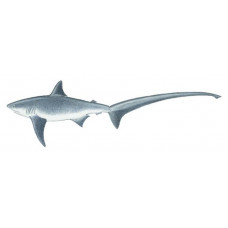Latin name
Alopias species
Other names
Fox shark, longtail thresher, pelagic thresher, sea fox, swiveltail, thintail thresher, thrasher shark.
Identification
Known by various names, the thresher shark is distinguished by its well-branched tail, whose upper blade is usually the same length as the rest of its body. These sharks use their tail to drive the bait fish into the mass by slapping or churning the water, and then stun or injure the fish before swallowing it. From grayish to dark charcoal, the thresher shark is sharply white on its belly and can be mottled on its lower half. Thresher is distinguished by the absence of a keel on the caudal process, small, pointed and widely spaced teeth, and relatively smooth skin. Longtail and pelagic threshers have moderate-sized eyes, and the first dorsal fin is located almost directly in the middle of their back and far ahead of the beginning of their pelvic fins. The Atlantic and Pacific bigeye threshers have much larger eyes, and the posterior edges of the dorsal fins are at least as far back as the beginning of the pelvic fins.
Distribution
There are four species, including the pelagic thresher (A. pelagicus) and Pacific bigeye thresher (A. profundis), which occur in the northwestern Pacific, and the Atlantic bigeye thresher shark (A. superciliosus), which occurs in the Atlantic. The longtail thresher (A. vulpinus) is a cosmopolitan in temperate and tropical waters. Threshers are excellent feeding fish, comparable to mako and swordfish, and are outstanding fighters (the longtail shark has been known to jump out of the water). Until recently, thresher sharks were more popular than makos off the coast of California, and are relatively rare on the U.S. Atlantic coast.
Habitat
All threshers are mostly pelagic, but sometimes come close to shore.
Size
Specimens weighing between 300 and 600 pounds are the most common size from New Jersey to Massachusetts. The largest threshers were caught in New Zealand, where they weighed over 800 pounds. The world record for A. vulpinus for all tackle is a fish weighing 767 pounds, 3 ounces, caught off the coast of New Zealand in 1983.
Life history and Behavior
No information
Food and feeding habits
No information
Reproduction
No information
| Classification | |
| Phylum | Chordata |
| Class | Chondrichthyes |
| Squad | Lamniformes |
| Family | Alopiidae |
| Genus | Alopias |
| Features | |
| Conservation status | No information |
| Habitat | Pelagic |
| Life span, years | 20 |
| Maximum body weight, kg | 500 |
| Maximum length, cm | 610 |
| Sailing speed, m/s | No information |
| Threat to people | Edible |
| Way of eating | Predator |






